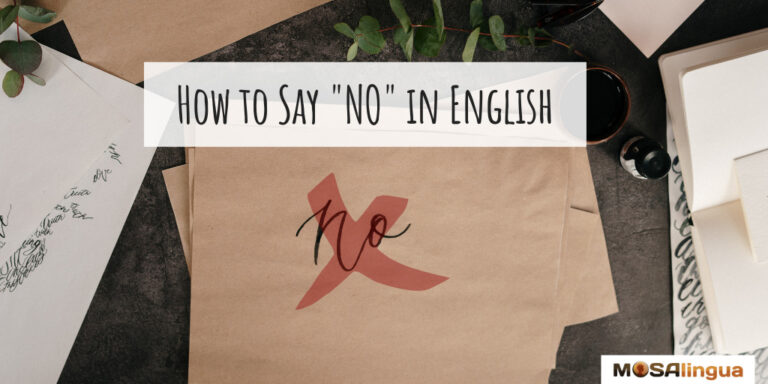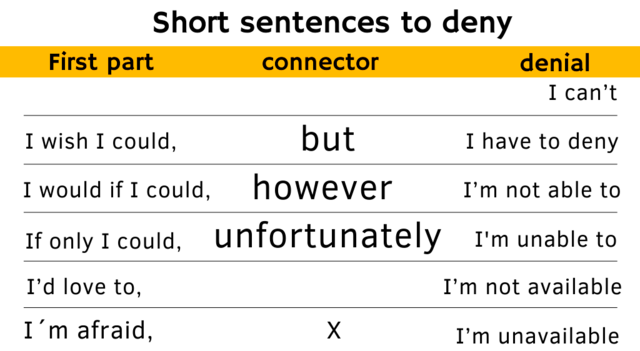Saying “no” is part of life. And for some of you who are learning English vocabulary, this two-letter word may be the only way you know to express that you disagree or to refuse an offer. But did you know that just saying “no” in English, or even “no thank you,” can sound a bit rude in some situations? That’s why, in today’s article, I’m going to show you how to say “no” in English in several formal, respectful, clear, and polite ways.

In your native language, answering a question with a simple “no” may not be a big deal. But in English, it’s different! There are much better ways to say “no” without leaving such a negative impression. In this article, we’ve gathered several phrases that you can use in your daily life.
They will be useful for both beginner and intermediate-level learners. They work well in professional contexts, and can be used in both written (email, for example) and spoken situations. Check them out below! Or, if you’d rather listen to this article, be sure to check out our MosaLingua Language Lab podcast:
Listen to “#69 – How to say “No” in English Politely!” on Spreaker.
What’s inside…
How to Say “No” in English (Politely!)
To begin, imagine the following scenario: at work, your boss asks you if you can participate in a project next quarter.
But you can’t, because you already have too much work. You know you won’t be able to commit enough time to this project. Obviously, you can’t just reply with a simple, “No thanks, I can’t.”
As I said before, the way we express ourselves can give others a positive or negative impression. To refuse an offer politely, it’s important to include three elements in your answer:
- Denial → Say that you can’t
- Justification → Explain why you can’t
- Gratitude/Apology → Express thanks for the offer or an apology
Part I: The denial
- “I wish I could, but I can’t.”
- “I would if I could, unfortunately I can’t.”
- or “I wish I could, however I can’t.”
Instead of using “I can’t” you can also say:
- “I’m unable to…”
- “I’m not available…”
- “I’m afraid I can’t…”
- or “I have to refuse.”
Check out these example sentences:
“If only I could! But I’m not available next quarter to work on this project.”
“I’d love to, however I have to refuse.”
Did you notice the comma in the above sentence? This comma marks a short pause. A pause that you must make between the first and the second part of the sentence. This is an important fluency detail.
One other important detail: the word “afraid” here does not mean that you are scared. In this context, “I’m afraid” is a synonym for “unfortunately.”
SUMMARY: Short phrases expressing negation in English
✏️ Now, it’s your turn! Try out some different combinations of these three elements and create your own denials. Write them in the comments section below.
Part II: Justification
Then we’ll add Part II of our sentence, the justification.
Whatever the justification for your refusal, you don’t need to give too much detail. Be brief and preface your justification with:
- “due to”
- “because”
- “as”
In the previous scenario, the justification was too much work. An idiomatic expression for this is “to have too much on your plate”:
“I wish I could, but I’m not able to accept this proposal for next quarter… as I/because I already have too much on my plate.”
If you don’t want the person to know why you are refusing, you can just say that you have “other commitments.”
“I’m unable to participate due to my other commitments.”
That sounds perfect!
Now, to finish, let’s put the cherry on top with Part III!
Improve your spoken English

Good news: we have a course for that: the Speak English with Confidence MasterClass.
It’s a comprehensive 10-module course designed to help you improve every aspect of your spoken English – fluency, confidence, pronunciation, and more – step by step, and enjoy doing it.
Part III: Gratitude and apology
You can put this element either at the beginning or at the end of the sentence. I prefer to put the apology at the beginning, and the “thank you” at the end.
That way I can end the sentence with positive words, leaving the listener with a better impression.
So what English words would you use to thank or apologize? Words like:
- “thank you”
- “sorry”
- and “I apologize”
To see some examples, let’s go back to the last sentence: “I’m unable to participate due to my other commitments.”
MosaTip: Put the person’s name at the beginning of the sentence for a more personal touch.
Expressing your gratitude
“Thank you, Mr. Wilson. However, I’m afraid I’m unable to participate due to my other commitments.”
“Mr. Wilson, thanks for considering me to participate in project X, however…”
Other phrases you can use to express gratitude are:
“It was really nice of you to think of me…”
“I’m honored by your proposal…”
Adding an apology
Now let’s talk about excuses. This part is optional: you may or may not need it.
If you must, then add “I’m sorry” or “I apologize” somewhere in your reply:
“I’m sorry Mr. Wilson, but I’m unable to participate due to my other work commitments.”
“Mr. Wilson, I wish I could participate with the upcoming project, however I can’t due to my other commitments. Sorry.”
“I apologize Mr. Wilson, I’m unable to participate in the project next quarter due to my other work commitments.”
All these sentences mean the same thing! In other words: you can be creative and think of new combinations.
How to be EXTRA polite
If you really want to impress, add the apology AND the thanks:
“Mr. Wilson, I’m honored by your proposal, however, I’m sorry to tell you that I can’t participate in project X next quarter as I already have too much on my plate. But thank you so much for thinking of me.”
How polite! By speaking like this, you’ll never feel bad about saying “no” again. And it will be very difficult for your boss to be angry with you!
BONUS VIDEO: How to Say “No” in English Without Seeming Rude
If you prefer to watch the video, or want to see how Lisa Joy pronounces each of these phrases, just click play below! Or click here to watch this video on the MosaLingua YouTube channel.
The video is in English, but if you need to, you can enable subtitles. To do this, just click on the gear icon in the lower right corner of the video. Then click on “subtitles” and choose the language you prefer.
Subscribe to our YouTube channel
Next Steps…
If you enjoyed this article and would like to learn more, check out the articles below:
- Express to Impress: 23 Ways to Say “Yes” in English [VIDEO]
- Talking on the Phone: How to Make and Receive Phone Calls in English [VIDEO]
- Greetings in English: Never Say Hello or Goodbye Again! [VIDEO]
You can also check out similar topics on our podcast, the MosaLingua Language Lab:
Listen to Episode #45 – Stop Saying “What?” on Spreaker
Listen to Episode #50 – Stop Saying “I Don’t Know” on Spreaker





Comments